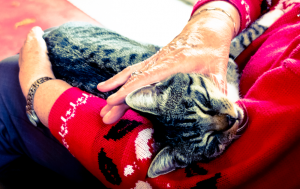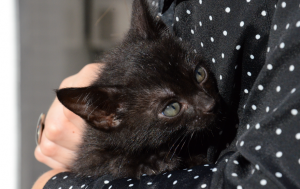
 Although less common than their canine counterparts in nursing homes, seniors’ residences and hospitals, special needs schools, libraries and day-care centers, the interest in and demand for therapy cats has been growing by leaps and bounds.
Although less common than their canine counterparts in nursing homes, seniors’ residences and hospitals, special needs schools, libraries and day-care centers, the interest in and demand for therapy cats has been growing by leaps and bounds.
Whether slowly and rhythmically stroking a cat or cuddling a purring one close, these seemingly simple actions can have a beneficial effect on an individual’s health. Research has proven that felines can both relieve stress and lower blood pressure in humans, while clinical studies have shown that being near them triggers the release of the “happiness” hormone, oxytocin, thus making people FEEL happy.
 With paws-itive results like these, there’s no mystery as to the rising popularity of pussycats as therapy cats. But what, precisely, is the process for turning your private, purr-sonal support system into a certified support system for others?
With paws-itive results like these, there’s no mystery as to the rising popularity of pussycats as therapy cats. But what, precisely, is the process for turning your private, purr-sonal support system into a certified support system for others?
While two of the best known organizations that certify pet therapy teams are Pet Partners and Love On A Leash, areas throughout the country have their own local organizations. Pet Partners’ Therapy Animal Program, one of the largest in the U.S., has been training volunteers nationwide since 1990.
Cat guardians interested in becoming the human half (known as the “handler”) of a cat therapy team must first determine if their cherished companion has the proper temperament to work with people. Ideal candidates are laid back and friendly, are comfortable around dogs and enjoy being handled by strangers from a very young age. They must also get used to wearing a leash and harness, traveling in a carrier, be at ease with loud noises and in unpredictable situations, be micro chipped and up to date on all vaccinations.
Most organizations have a minimum age for participation. Pet Partners, e.g., requires that a cat be at least a year old and know his/her handler for at least six months. They also require that a cat NOT be fed a raw protein diet. Why? These diets put people — particularly those with compromised immune systems — at a greater risk for infection.
 If the organization is satisfied that you have met all of their requirements, you can choose to undergo a training course either online or in person. Once the course has been successfully completed, you and your cat will be evaluated by an expert before being taken – as a team — on a number of supervised visits to the facility you’ve chosen as yours.
If the organization is satisfied that you have met all of their requirements, you can choose to undergo a training course either online or in person. Once the course has been successfully completed, you and your cat will be evaluated by an expert before being taken – as a team — on a number of supervised visits to the facility you’ve chosen as yours.
Then, with the trial period over, you and your freshly certified therapy feline will be ready to bring a smile to a senior’s face, make a student’s day brighter, reprise a cherished memory, or soothe a restless soul.
Here in Vancouver, Washington Furry Friends has a Pet Therapy program. If you have a cat or dog that is good with people, you might look into this. It is only a one hour a week commitment. To find out more about the program, please watch this short video.
